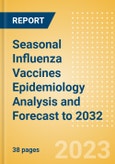Symptoms of influenza are headache, fever, cough, sore throat, and aching muscles and joints. The influenza virus tends to cause more severe disease in infants, elderly people, young children, and those with a weakened immune system (WHO, 2023). The World Health Organization (WHO) estimates that approximately 5-10% of adults and 20-30% of children are affected by an influenza-like illness (ILI) annually (WHO, 2023).
Scope
- Seasonal Influenza (SI) vaccines Epidemiology Report provides an overview of the risk factors, comorbidities, and global trends of SI in the seven major markets (7MM: US, France, Germany, Italy, Spain, UK, and Japan).
- The report includes a 10-year epidemiological forecast for the diagnosed incident cases of influenza- like illness (ILI), and lab-confirmed SI segmented by age (0-4 years, 5-17 years, 18-64 years, and ≥65 years) and sex. The report also includes a 10-year epidemiological forecast for the SI vaccinated population segmented by age (0-4 years, 5-17 years, 18-64 years, and ≥65 years).Seasonal Influenza (SI) vaccines Epidemiology Report and Model provide an overview of the risk factors, comorbidities, and global trends of SI in the seven major markets (7MM: US, France, Germany, Italy, Spain, UK, and Japan).
- The report includes a 10-year epidemiological forecast for the diagnosed incident cases of influenza- like illness (ILI), and lab-confirmed SI segmented by age (0-4 years, 5-17 years, 18-64 years, and ≥65 years) and sex. The report also includes a 10-year epidemiological forecast for the SI vaccinated population segmented by age (0-4 years, 5-17 years, 18-64 years, and ≥65 years).
Reasons to Buy
- Seasonal influneza vaccines epidemiology series will allow you to:
- Develop business strategies by understanding the trends shaping and driving the global SI vaccines markets.
- Quantify patient populations in the global SI markets to improve product design, pricing, and launch plans.
- Organize sales and marketing efforts by identifying the age groups and sex that present the best opportunities for SI therapeutics in each of the markets covered.
Table of Contents
- About the Publisher








